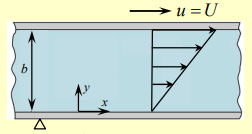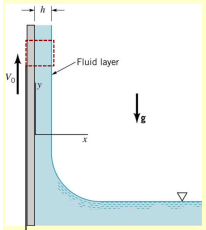Couette flow involves steady, incompressible flow between two parallel plates, where the flow is induced by the motion of the upper plate.

- Two infinite plates are placed at and
- The bottom plate is stationary, while the top plate moves with velocity in the x-direction
- Fluid is sheared due to the motion of the upper plate
The continuity equation for incompressible fluids gives us
The Navier-Stokes Equations give us

Solving the ODE from the -component by integrating:
We can solve for the constants by applying the stick/no-slip boundary conditions.
At :
At :
Thus, we finally get:
Alternatively we can write
This is a superposition of:
- A linear shear profile due to the moving plate
- A parabolic pressure-driven profile (like in plane Poiseuille Flow)

Example: Gravity-Driven Film Flow on a Vertical Wall
This example focuses on a thin fluid film flowing down a vertical wall under gravity. It’s a viscous, incompressible, laminar flow and assumes steady-state conditions. Our goal is to find the average velocity .

We also know that since , the continuity equation for incompressible fluids gives:
Also, the pressure is constant across the free surface :

The Navier-Stokes equations give:

Integrating the -component to find the velocity profile:
We can use boundary conditions to solve for the constants.
- At the wall , we have the no-slip condition such that :
- At the free surface , we have :
Thus, the final velocity profile is:
The volumetric flow rate: